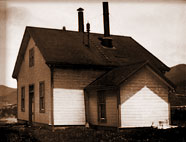

The first known fog signal used in the United States was a cannon that accompanied the lighthouse at Boston Harbor in the early 18th century. Cannons were commonly used as fog signals throughout the 18th and 19th centuries, providing a warning that could be heard for miles from its source. In places where lighthouses were not equipped with or accompanied by fog signals, it was not uncommon for keepers to fire shotguns in heavy fog to help warn ships that might not have been able to see the local lighthouse.
Large bells were also used quite often as fog signals at the locations of lighthouses and on lightships, as well. Even though they had to be rung manually, either by a hammer or an internal clapper, many bells were retained as reliable backups after horns and sirens replaced them. Eventually, devices such as the Steven’s fog bell helped to automate the ringing of a bell at set intervals. Today, foghorns usually produce their sounds electronically or by releasing quick blasts of air. These modern sound signals assist in navigation by providing a distinct combination of sounds to help alert ships of where they are or guide them where they need to go.
